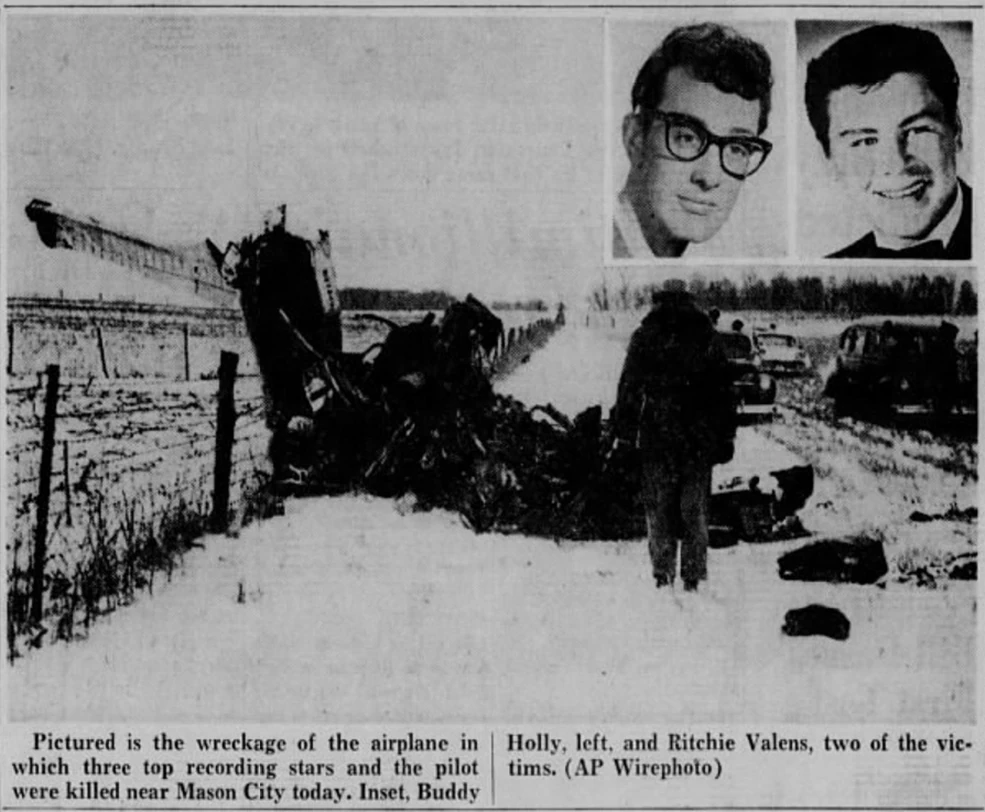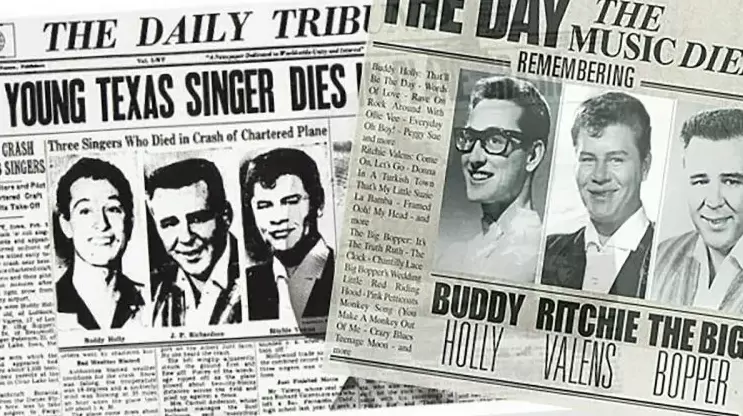This is the fourth article in a series about The Day The Music Died. The last article left off with Carroll Anderson, manager of the Surf Ballroom, giving Buddy Holly, Ritchie Valens, and J.P. Richardson, aka The Big Bopper a ride to the Mason City Municipal Airport. They arrived there around 12:40 a.m. on Friday, February 3, 1959. Twenty-one-year-old pilot Roger Peterson had the four-seat Beech Bonanza aircraft warmed up and ready to go. At 12:55 a.m. the plane took off as a light snow began to fall.
The Beech Bonanza headed in a southerly direction at takeoff, reached an altitude of 800 feet, and then turned in a northwesterly direction. Jerry Dwyer, who owned the flying service that arranged the flight, watched from the control tower as the plane’s lights began to descend and then go out of sight at approximately four to five miles from the airport. He thought it was an optical illusion.
It wasn’t.

The rest of the Winter Dance Party rode the bus the 400 miles to Moorhead, MN, overnight. J.P. Richardson had purchased a sleeping bag in Green Bay before leaving the city and used it on the ride to Clear Lake, IA. Tommy Allsup appropriated the sleeping bag and spent a relatively warm and restful night on the bus. He was the first one off the bus and walked into the hotel to check in. He noticed J.P.’s picture on the TV screen in the lobby but thought it was some promotional spot. Then he asked the desk clerk what room Buddy was in.
Tommy walked back to the bus and boarded it as the rest of the troupe was just arising, yawning and stretching to come fully awake. He was a man of few words but a few words were all he needed now. “Fellas,” he said, “they didn’t make it.”
* * * * *
There was some confusion initially regarding just who was on the plane when it crashed. Some early newscasts reported it was Buddy Holly, Ritchie Valens, J.P. Richardson, and Tommy Allsup who were killed in the crash. Others said it was Buddy, Tommy, and Waylon Jennings. Tommy and Waylon made calls to relatives unaware their families were hearing reports of their demise. It was mid-afternoon following a flurry of phone calls when the news began to sink in and become reality.

Maria Elena Holly was still in bed in the fourth floor apartment she shared with Buddy at the junction of Fifth Avenue and Ninth Street in New York when she received a call from Lou Giordano. Lou was a young singer who was working with Buddy. He warned her not to turn the TV on and to stay in bed until he arrived. She would later say, “Well of course when someone tells you not to do something like that you do it right away.”
Maria learned from a television broadcast that her husband of a few months had died in a plane crash earlier that morning. She suffered a miscarriage attributed to psychological trauma shortly thereafter.
* * * * *
Carl Bunch was still in Grand View Hospital near Ironwood, MI. He recalls hospital staff staring at him as they wheeled him down the hall to take a phone call from his mother. She asked what he was going to do. He told her he would get back out on the road once he healed because he had a job to do. She asked again, “What are you going to do now?” He repeated it would take a day or two but he would get back out there as he had a job to do.
She sighed and said, “You don’t know they were killed, do you?” Carl was in shock at the news and did not know how to respond.
* * * * *
There is an old show business adage declaring, “The show must go on.” Putting on a show is a business after all and money had already been invested in preparing venues for shows scheduled in various cities. This included the Moorhead Armory in Moorhead, MN, site of the show scheduled for February 3. Tommy Allsup and Waylon Jennings were asked by General Artists Corporation (GAC) to stay on the tour to back up the other acts. GAC promised to take care of them financially. However, when the tour was over all they got was train fare home. GAC claimed the tour lost money and too many expenses had been paid up front.
The show in Moorhead was sold out and all 2,000-ticket holders were in attendance. Frankie Sardo started the show by singing “Donna” and other songs by Ritchie Valens as a tribute to his lost friend. A local band fronted by Bill and Bobby Velline was up next. The band did not have a name but at the spur of the moment Bobby came up with one – The Shadows. The group was a hit and the audience started to liven up. Bobby Velline would go on to be better known as Bobby Vee. Many in attendance that night thought he sounded eerily like Buddy Holly.
* * * * *
The show in Moorhead closed with Tommy Allsup on guitar, Waylon Jennings on bass, and Carlo Mastrangelo of the Belmonts on drums. They made their one and only appearance as Buddy Holly’s Crickets, with the teenage audience screaming and clapping enthusiastically in appreciation.
Jimmy Clanton, Frankie Avalon, and Debbie Stevens replaced Buddy, Ritchie, and J.P. Richardson for the remaining stops on the tour. The show must go on even if its stars cannot.
As for those left behind, many found it difficult to go on.
* * * * *
The material in this series is derived from many sources, including Rave On by Phillip Norman; The Day The Music Died by Larry Lehmer; and, The Rolling Stone Encyclopedia of Rock & Roll, 3rd Edition.



